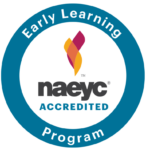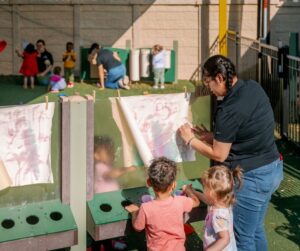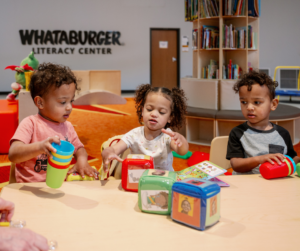 At Brighton Preschool we pride ourselves on providing high-quality early childhood education. That is why our preschool is accredited by the National Association for the Education of Young Children (NAEYC), the industry’s gold standard for child care and early childhood education. Our infant classroom, transition classroom, pre-k classroom, and kindergarten-ready classroom offers excellent learning opportunities for every age. In this blog, we will explore why NAEYC accreditation is important for preschools, how it benefits children and families, and what the accreditation process involves.
At Brighton Preschool we pride ourselves on providing high-quality early childhood education. That is why our preschool is accredited by the National Association for the Education of Young Children (NAEYC), the industry’s gold standard for child care and early childhood education. Our infant classroom, transition classroom, pre-k classroom, and kindergarten-ready classroom offers excellent learning opportunities for every age. In this blog, we will explore why NAEYC accreditation is important for preschools, how it benefits children and families, and what the accreditation process involves.
What is NAEYC accreditation?
The National Association for the Education of Young Children (NAEYC) is a professional organization dedicated to promoting high-quality early learning for all young children. NAEYC accreditation is a voluntary process that early childhood programs can undergo to demonstrate their commitment to providing high-quality education and care to young children.
Programs that meet NAEYC’s rigorous standards receive accreditation, which signifies that they are among the best early childhood education programs in the country.

Why is NAEYC accreditation important for preschools?
Here are several reasons why preschools should strive to achieve NAEYC accreditation:
NAEYC accreditation is a mark of quality.
By undergoing the accreditation process, preschools demonstrate they meet NAEYC’s highest standards for early childhood education.
NAEYC accreditation promotes continuous improvement.
-
- The accreditation process involves a rigorous self-assessment, as well as external evaluation by NAEYC assessors.
- This process helps preschools identify areas where they can improve their practices and policies, and work towards achieving the highest standards of quality in early childhood education.
NAEYC accreditation benefits children.
-
- Preschools that achieve NAEYC accreditation commit to providing the highest quality early learning experiences for young children. This includes:
Providing developmentally appropriate curriculum.
Engaging in activities and experiences.
Nurturing relationships with caring adults.
All of these factors contribute to positive outcomes for young children. In particular, these positive outcomes include improved school readiness, social-emotional development, and academic achievement.
NAEYC accreditation benefits families.
-
- Parents and families can have confidence in the quality of education and care their children are receiving when they choose NAEYC-accredited preschool.
- They can be confident that the program meets high standards for health and safety, curriculum, teaching, and family engagement.

What does NAEYC accredited preschool look like?
Parents who visit a preschool that is NAEYC accredited can expect to see a high-quality early childhood program that meets NAEYC’s rigorous standards for early learning.
Here are some specific things that a parent might see in NAEYC-accredited preschool:
- A welcoming and nurturing environment: NAEYC-accredited preschools provide a welcoming and nurturing environment that supports children’s social-emotional development. Parents might see warm and responsive caregivers who are attentive to a child’s needs. Furthermore, the classrooms are designed to be safe, inviting, and inclusive.
- Developmentally appropriate curriculum: NAEYC-accredited preschools provide developmentally appropriate curriculum designed to meet the needs of young children. For instance, parents might see classrooms full of engaging and age-appropriate materials, and teachers who use a variety of teaching strategies to support children’s learning and development.
- Health and safety practices: NAEYC-accredited preschools prioritize the health and safety of young children. Parents might see classrooms that are cleaned and sanitized regularly, teachers who practice good hygiene and handwashing. Additionally, on the administrative side parents may see policies that promote the safety of all children in the program.
- Family engagement: NAEYC-accredited preschools value and encourage family engagement in children’s learning and development. Moreover, parents might see opportunities to participate in their child’s education, such as parent-teacher conferences, family events, and volunteer opportunities.
- Ongoing professional development: NAEYC-accredited preschools commit to ongoing professional development for their staff. For example, parents might see teachers who are knowledgeable about early childhood education and who participate in regular training and development opportunities.
Overall, parents who visit NAEYC-accredited preschool can expect to see a high-quality early childhood program that is designed to meet the needs of young children and support their growth and development. By choosing NAEYC accredited programs, parents can have confidence in the quality of education and care their children are receiving.

What does the NAEYC accreditation process involve?
The process is comprehensive and involves several steps:
- Submitting an application: Preschools interested in becoming NAEYC-accredited must first submit an application and pay a fee. As a result, the accreditation process beings.
- Conducting a self-assessment: The next step is for the preschool to conduct a self-assessment. Specifically, this involves reviewing the program’s policies and practices in all areas of early childhood education.
- Preparing a portfolio: Based on the self-assessment, the preschool must prepare a portfolio that documents how the program meets NAEYC’s standards for early childhood education.
- Receiving an on-site visit: After the preschool submits their portfolio, NAEYC assessors conduct an onsite visit to the program. During the visit, assessors observe classrooms, review documentation, and interview staff, children, and families.
- Receiving accreditation: If the program meets all of NAEYC’s standards, it receives accreditation. On the other hand, programs that do not meet all of the standards receive a report that identifies areas for improvement.
- Maintaining accreditation: NAEYC-accredited programs must maintain their accreditation by meeting ongoing requirements, such as submitting annual reports and participating in periodic re-evaluations.
In conclusion, NAEYC accreditation is an important measure of quality for preschools. Achieving accreditation demonstrates a program’s commitment to providing high-quality education and care for young children, and benefits children, families, and the program itself. The accreditation process is rigorous and comprehensive. Nevertheless, the benefits for young children and families make it well worth the effort. For more information visit https://www.naeyc.org.






